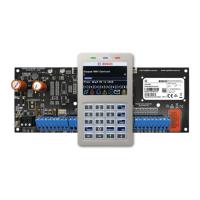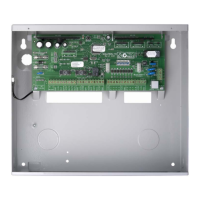11Bosch Security Systems 3/23 BLCC610U
Solution 6000 User Guide
How to Use DTMF Control
1. Once the panel answers the incoming call, the panel
will play a short welcome jingle. You now have
approximately 5 seconds to enter a valid PIN and log
onto the panel.
2. Enter PIN followed by the [#] key on your phone. If
the PIN is valid the system will respond with two
short beeps. If the PIN is invalid then a single long
beep will be heard.
If a valid PIN is not entered in time, the panel will attempt
to establish a modem connection as if connecting to
the Solution Link software.
If this happens you will need to hang up for
approximately 60 seconds before trying again.
3. Once validated, the following commands can be
performed.
If no keys are pressed for 20 seconds or the user presses
[#] [#], the control panel will play the exit jingle and
terminate the session.
DTMF CONTROL FUNCTIONS
Operation Command
Tone
Response
Quick Arm
All Areas [0] + [#]
High,
Medium,
Low
Log In
OK
[PIN] + [#] Low, High
Error
Incorrect Entry
Long
Beep
Turn Area
All On
[1] + [Area Nº] + [#] + [1] Low, High
Turn Area
Off
[1] + [Area Nº] + [#] + [2] High, Low
Turn
Output On
[2] + [Output Nº] + [#] + [1] Low, High
Turn
Output Off
[2] + [Output Nº] + [#] + [2] High, Low
End
Session [#] + [#]
High,
Medium,
Low
Table 5: DTMF Remote Control Functions
DTMF EXAMPLES
Each example below shows the log on step for clarity. In
practise is only necessary to log on once per DTMF control
session.
To log on and turn Area 1 All On, enter the following:
[2] [5] [8] [0] + [#] = Log ON
[1] + [1] + [#] + [1] = Arm Area 1
To log on and turn Output 8 on, enter the following:
[2] [5] [8] [0] + [#] = Log ON
[2] + [8] + [#] + [1] = Turn Output 8 ON
To log on and turn Output 6 off, enter the following:
[2] [5] [8] [0] + [#]
= Log ON
[2] + [6] + [#] + [2]
= Turn Output 6 OFF
If the DTMF Quick Arm option is enabled then it is possible
to remotely turn on all areas without logging onto the
panel. Simply enter [0] + [#] following the welcome jingle.
Make sure that the telephone being used to
remotely control the panel is set to transmit DTMF
tones when keys are pressed during the call. This
option is disabled by default on some telephones.
Programming Text Using The Keypad
When programming text via the keypad, various keys on
the keypad operate differently.
A group of characters is assigned to each of the numeric
keys on the keypad. Pressing the same numeric key again
will toggle to the next character assigned to the key (eg.
Press the [2] key will display the ‘A’ character, press the [2]
key again will toggle to the ‘B’ character, press the [2] key
again will toggle to the ‘C’ character etc).
Once the correct character is display use the arrow keys to
move to the next letter of the word you are entering. The
key assignments are identical to those found on most fixed
and mobile phones.
When programming text, each numeric key represents a
different group of characters.
Pressing the same numeric key repeatedly will step you
through the available characters assigned to the key. The
text key layout is the same as most phones. Refer to the
table below for detailed character information.
Refer to the following table for more information.
Key Characters Assigned To Each Numeric Key
1 . , ? ! - & ` 1
2 A B C a b c 2
3 D E F d e f 3
4 G H I g h i 4
5 J K L j k l 5
6 M N O m n o 6
7 P Q R S p q r s 7
8 T U V t u v 8
9 W X Y Z w x y z 9
0 SPACE 0
Scroll Up through entire character list
Scroll Down through entire character list
Move to left one character position
Move to right one character position
OFF Clear from cursor postiion to end of line
Table 6: Text Keypad Character Set
Once the desired character is displayed press the right []
arrow key to move to the next character position. To save
programming changes, press [OK], or press [MENU] to exit
without saving.
The following additional special characters are available
by scrolling using the up and down arrow keys.
+ - @ # $ “ & % * : ( ) / < > =

